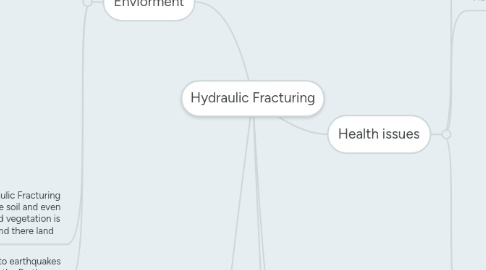
1. Goverment
2. Enviorment
2.1. Pollution
2.1.1. Water Pollution
2.1.1.1. Fracking uses uses about 2-8 million gallons of water or even more
2.1.1.2. Chemicals are added to water making it undrinkable
2.1.1.3. Water becomes so polluted withe chemicals it cant even be called water anymore
2.1.1.4. To convert the contaminated water back into heathy drinking water is too expensive for the government so instead they pick the cheaper route which is to store the water underground
2.1.1.5. Water can become so toxic from the chemicals that in some cases the water becomes flammable
2.1.2. Air Pollution
2.1.2.1. Methane a chemical which is four times stronger than carbon dioxide is used for Hydraulic Fracking. About four percent of the methane used is released into Earths atmosphere
2.1.2.2. Air in fracking sites can become so toxic it can cause people to fall seriously ill. Even by only driving past the site can cause a persons eyes, nose and throat to irritate.
2.1.3. Ground Pollution
2.1.3.1. The contaminated water left from Hydraulic Fracturing is usually sent back into the ground causing ground water to pollute and the ground itself to become polluted with toxic chemicals.
2.2. Oil spills can occur during Hydraulic Fracturing which can dangerously harm the soil and even vegetation. Harming the soil and vegetation is devastating to nearby farmers and there land
2.3. Hydraulic Fracturing is linked to earthquakes from the constant drilling into the Earth.
3. Health issues
3.1. Fracking releases unhealthy amounts of toxic chemicals into the air which can be atrociously unhealthy for nearby humans and wildlife
3.2. Humans
3.2.1. Exposure to the pollution around fracking sites can cause nose, eyes, and throat irritation
3.2.2. Fracking can cause nervous system damage, birth defects, cancer, respiratory system damage, immune system damage, and even premature death for workers and nearby residents
3.2.3. Pregnant women who live near fracking sites are more prone to having miscarriages and their child is more likely to be born with heart defects
3.2.4. Various employees from Hydraulic Fracturing have reported serious health issues after exposure from toxic chemicals released during fracking.
3.2.5. The chemicals released during fracking can also cause shortness of breath, headaches, dizziness, nose bleeds, and chest tightness.
3.3. Wildlife
3.3.1. Livestock can experience illness, sudden death, digestive system damage, brain damage, nervous system damage, cancer, and kidney infections
3.3.2. Due to the more livestock dying there will be a less production of milk, eggs, and meat
3.3.3. Wildlife close to the fracking site are more prone to death
3.3.4. Organisms who live underground lose there home due to fracking sites drilling underground
3.3.5. Fracking also ties in with biodiversity. Since nearby animals are dying because of fracking this causes a chain reaction in the community the animal is from. For example, if the grizzly bear population was to dramatically decrease, the salmon population would increase due to the fact a grizzly bears main diet is salmon. This would end up being a bad thing because the rivers would be overly full with salmon causing problems for other organisms living in the river.
